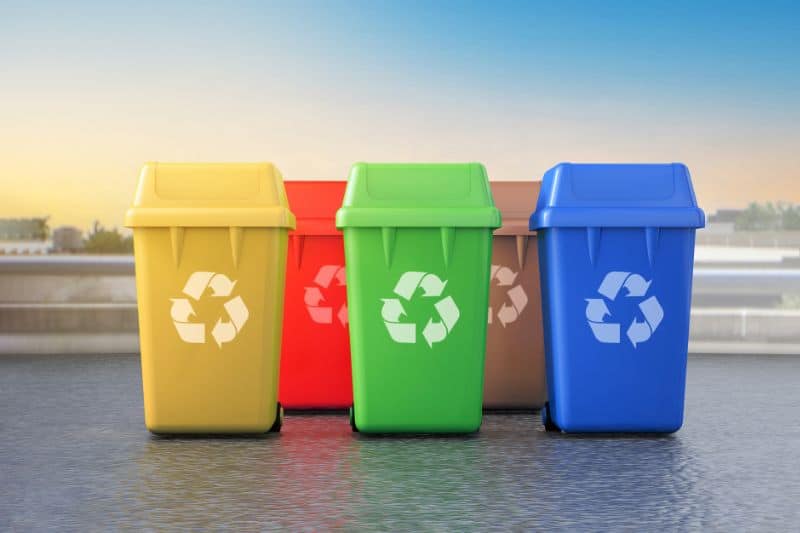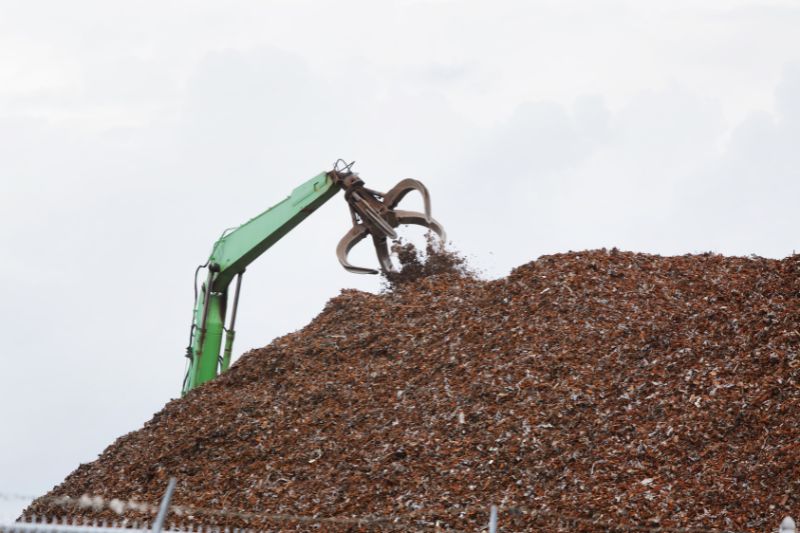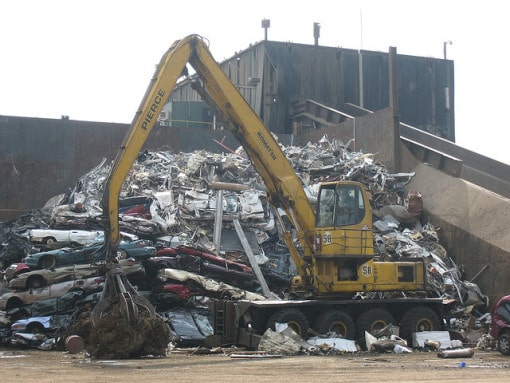Metals are essential and versatile, commonly used in a number of ways ranging from the manufacture of trucks, cars, airplanes, ships, and railways to the making of domestic everyday home use items such as cutlery, crockery, and even packaging.
In other words, metal is one of the materials we interact with the most in our everyday lives.
That means it also makes a significant portion of our waste, often leaving any environment-conscious mind with the question of whether it can be recycled.
So, can metal be recycled? Well, the answer is affirmative, meaning that metal can be recycled. In fact, this can happen over and over without altering its properties, unlike most plastics.
The most common recyclable metals include aluminum and steel. The other metals, for example, silver, copper, brass, and gold, are so valuable that they are rarely thrown away to be collected for recycling. Therefore, they do not create a waste disposal crisis or problem.
The Metal Recycling Process
The metal recycling process is somewhat similar to the usual recycling process. The metals are first sorted based on their properties. That means it’s essential to have a basic understanding or knowledge about each of the metals. This will help in recycling them and keeping a green environment.
The metal recycling process follows the following steps:

1. Collection
This is the first and most crucial step in metal recycling. It simply involves collecting all materials that are made of metals. This process involves availing containers specifically designed to collect metals.
In some cases, scrap yards are utilized, whereby people are encouraged to collect different metals, take them there, and be paid for what they have collected. Different metals cost differently at the yards. The scrap metal yards are used as collecting centers for the metals.
2. Sorting
Once the metals have been collected, the next important step is to sort them. This involves separating what can be recycled from what can’t. It is essential to point out that the quality of metal recycled is very important.
Keep in mind that a high-quality recycled product or item can only be created if the original materials used in the recycling process are of good quality. This, therefore, calls for a strict quality checkup during the sorting process.
The general rule is that a product needs to be at least 50 percent metal. Even if that metal is surrounded by other materials like plastic, it’s worth recycling if it’s made primarily out of metal.
But there’s an exemption for non-metal items whose metal parts are easily removable. A case in point is a three-ring binder. Although it’s not primarily made of metal, the metal rings can be easily removed, used, and recycled.
Scrap metal is classified as either ferrous (containing iron, such as steel) or nonferrous (everything else). The way to identify whether the metal is ferrous or nonferrous is with a magnet.
As ferrous metals contain iron, they stick to a magnet, while nonferrous metals don’t and are easily pulled out of the mixed waste stream.
These days, in large recycling facilities, using sensors to identify metals through infrared scanning and X-ray has become popular. Examples of these metal sensing processes include biotechnology, hydrometallurgy, and pyrometallurgy. The use of these technologies can effectively improve metal recovery rates.
3. Processing
After sorting, the next step is to compact or squeeze the metal. All the recycled materials are squeezed and squashed using machines so they do not occupy so much space in the conveyor belts.

4. Shredding
After the crushing and breaking of the metal, the shredding process starts. The metals are broken down into tiny pieces or sheets for further processing.
The reason for shredding is to give the metal pieces a large surface area-to-volume ratio, meaning they can be melted using less energy. Normally, steel is changed into steel blocks, on the other hand, aluminum is converted into sheets.
5. Melting and Purification
Melting of the scrap metal takes place in a large furnace. Each metal is taken to a furnace that is specifically designed to melt that particular metal based on its specific properties.
The melting process uses a considerable amount of energy. However, the energy required for melting recycled metal is less than that required to make metal from its raw material.
The furnace is heated to appropriate degrees, capable of melting the particular metal on board. The process can take minutes or hours depending on how big the furnace is, the volume of metal placed in the furnace, and the heat degree of the furnace.
6. Purification
After the melting process is complete, the next step is the purification process. Metals are purified using different methods, and the purification process is generally done to ensure that the final product is free of impurities and high quality. Electrolysis is one of the methods of purifying metals.
Other metals are simply passed under powerful magnetic systems that separate metals from other recyclables. Today, there are different purification methods depending on the type of metal.
7. Melting and Solidifying of the Metal
After purification, the conveyor belt carries the molten metal to a cooling chamber, where it is cooled and solidified. At this stage, the scrap metal is made into a solid metal that can be used again.
Other chemicals are then added to the molten metal to make it acquire its density and other properties. It is at the cooling stage that different shapes and sizes of metals are made and designed.
8. Transportation of the Metal Bars
Once the bars have been designed and made, the final product is then packed depending on the intended sizes and shapes, ready for transportation to different factories and to people who require the metal. Thereafter, the cycle begins again.

So, Why Is It Important to Recycle Metal?
Some people disregard the need for recycling solid waste, especially metal. Some throw them away, while others leave the metal to rot away.
However, if you understand the numerous benefits of recycling these items, you will no longer throw them away or leave them to be eaten away by rust or weather elements.
The following are some of the benefits of recycling metals:
1. Preservation of Natural Resources
This is one of the main reasons why people should recycle metal. Metal is excavated from the earth through a process called mining.
Over time, the areas excavated tend to be depleted, and the miners move to other places looking for metals to mine. This means that if this trend does not stop or is not controlled, most places will have substantial excavation holes.
By providing an alternative to virgin ore, recycling metal helps to reduce the devastating effects of mining. Mining operations not only destroy delicate natural habitats but also pollute the surrounding air, water, and soil.
Toxic runoff can occur while a mine is in operation and even affect lakes, streams, and marine environments for subsequent decades long after it has been shut down. Therefore, to prevent this and preserve the environment, it is important to recycle metal.
2. Reduction of Emissions
Have you heard of global warming? It’s a phenomenon brought about by the steady increase in carbon dioxide emissions in the atmosphere.
Although it is hard to undo what has already been done to the atmosphere in terms of destroying the ozone layer and global warming, we can control or stop causing further damage. This can be done by embracing the recycling of metal and other solid waste.
Metal recycling conserves natural resources by reducing greenhouse gas emissions and using less energy than making metal from virgin ore. The production of new metal releases a far more significant amount of greenhouse gas emissions than making products from recycled metal.
These emissions may influence climate change and may also cause harmful levels of air pollution in cities, resulting in potential respiratory health problems for you and other residents. The Institute of Scrap Recycling Industries (ISRI) reports that recycling metal may cut greenhouse gas emissions by 300 million to 500 million tons.
3. Economic Development
Through recycling, the government can save a lot of money that could be spent on mining and processing metals. The money saved can be channeled into other development programs that can help improve the living standards of the people and the economy as a whole.
Additionally, by exporting recycled metals, the government can generate more revenue, improve the socio-economic status of its citizens, and provide jobs to the unemployed.
In fact, it is estimated that recycling metal creates 36 times more jobs than sending the same amount of metal waste to the incinerator and six times more than sending the metal to a landfill, according to the National Institute of Health.
The National Recycling Coalition says the recycling industry generally generates $236 billion annually and employs more than a million workers across America.
4. Management of Energy Consumption
Recycling metal reduces the growing demand for natural resources such as ore. When more and more metals are recycled, the demand for the natural metal is reduced.
On top of that, less energy is required to process scrap metal than it is required to extract ore from the earth, purify it, and later shape it into desired shapes and sizes.
The energy saved using various recycled metals compared to virgin ore is up to 92 % for aluminum, 90 % for copper, and 56 % for steel.
According to the US Environmental Protection Agency, if you recycle a single aluminum beverage can, you help conserve enough energy to power a 60-watt light bulb for more than four hours. The preserved energy can be used for other purposes in the economy.
5. Make Room in Landfills for Non-Recyclable Items
Landfills are becoming more and more overcrowded with both trash and recyclable items. Recycling is a must to preserve this precious landfill space. This mainly pertains to scrap metal recycling.

6. Improves Air Quality and Groundwater
The garbage in landfills contributes to the emission of greenhouse gases. Keeping metal out of landfills helps reduce this harmful result.
Furthermore, when the trash is buried in landfills, it contaminates the soil, eventually making its way into the groundwater supply when rain carries it into the reservoirs holding drinking water.
7. Business Opportunities in Metal Recycling
Traditionally, metal recycling has been regarded as a profitable business opportunity. At an entrepreneurial level, a common entry point into the metal recycling business is through starting a scrap metal collection business or becoming a scrap metal vendor. However, in recent years, depressed prices have proved to be challenging.
8. Saves You Money
This is one of the best yet most ignored reasons. If most people recycled metal and metal items regularly, it would be less costly to produce metal in terms of energy and the ore required. This will mean that the actual cost of buying metal will be reduced, saving you some money.
To conclude, metal is an essential resource that should be recycled to ensure a steady supply, prevent environmental degradation, and improve the economy.
References:






